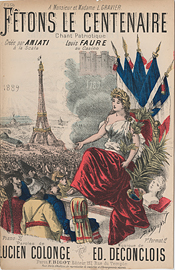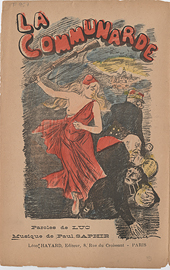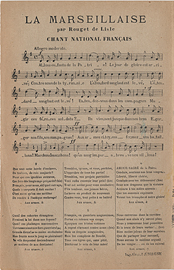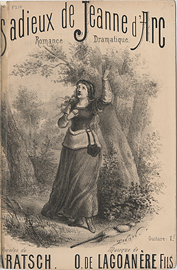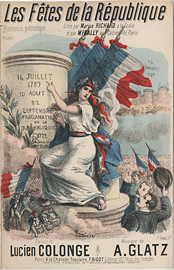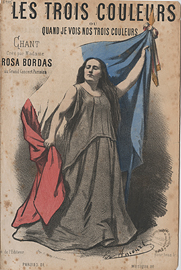Her voice possesses a charm, an emotion that penetrates you, draws tears, and inspires heroism.
– Chadourne on Amiati, Les cafés-concerts (1889, 246).
Throughout the nineteenth century, images of women were frequently used as political symbols to foster patriotic sentiment. As historian Joan Landes has noted, “representations of women within popular imagery promoted the ideals of French republicanism and contributed to individuals’ self-understanding as citizens of the nation-state” (2001, 1). Both Jeanne d’Arc and Marianne (the latter famously depicted in Delacroix’s painting of the 1830 July Revolution, Liberty Leading the People) were important female symbols within the nineteenth-century French imagination. With her Grecian robe and her arm raising the tricolor flag high in the air, Marianne came to embody the republican sentiments of liberty, equality, and fraternity.
Women evocative of Marianne appeared on the covers of a number of French songs during the second half of the century, in celebration of the centennial of the French Revolution or to represent various political movements. Women also participated in the Paris Commune, and both La sociale and La communarde employ the identical image of Marianne brandishing a gun to promote political action. Whereas Republican and leftist political factions embraced Marianne, Jeanne d’Arc served as a representative of heroism and purity often (though not exclusively) for the catholic conservative and right wing factions of Third Republic France. Over the century, Jeanne d’Arc inspired numerous poems, paintings, plays, ballets, and musical works, from operas to art songs.
Following the defeat of France in the Franco-Prussian War (1870–1871) and the turbulence of the Paris Commune (1871), sentimental and populist romances patriotiques, chants patriotiques, chansons dramatiques, and cris patriotiques of the café-concert were intended to inspire the suffering populace. The café-concert singer Amiati (1851–1889) excelled in these genres and was considered the “priestess” of the revanchist chanson (Chadourne, 1889, 246).


